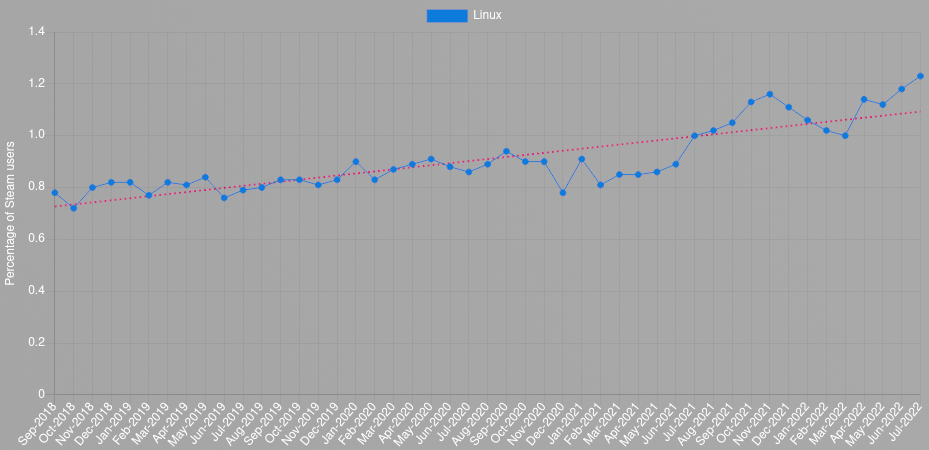Valve has put out their usual monthly Steam Hardware & Software Survey and it's looking like good news for Linux and Steam Deck once again.
We've seen the user share rise up to 1.23%, making it the highest point in multiple years (again). If we use Valve's last monthly active user count, that points the monthly active Linux user count somewhere around 1,623,600. See more on our Steam Tracker. Linux has remained at 1% or above for at least a full year now too.
According to the survey when filtering just to Linux, here are the most popular distributions:
- Arch Linux 64 bit 13.87% +2.45%
- Manjaro Linux 64 bit 11.40% +1.29%
- Ubuntu 22.04 LTS 64 bit 9.78% -0.12%
- Ubuntu 20.04.4 LTS 64 bit 9.28% -0.45%
- SteamOS Holo 64 bit 7.60% +0.02%
- Linux Mint 20.3 64 bit 6.29% -0.16%
- Freedesktop.org 21.08.14 (Flatpak runtime) 64 bit 5.29% -0.76%
- Pop!_OS 22.04 LTS 64 bit 4.90% +0.11%
- Other 31.60% -2.36%
So we're seeing Valve's SteamOS now make up 7.6% of the Linux gaming audience on Steam, which is a pretty good early showing for the Steam Deck. In terms of hardware, on the Linux side the Steam Deck appears to be the most popular device as it's now top of the list of GPUs used too.
Which makes me wonder . . . I knew the Chinese essentially didn't use Linux, like, at all. For desktops/gaming, anyway. But what about all the other non-English speakers? For the overall percentage to be less than half the English-speaking percentage, no-Linux has to be very common out there. Why is Linux so terrible at penetrating beyond the English speaking (gaming) world?Probably the Linux gamers in foreign countries have set their OS language to English because of missing or broken translations. Also there is the point that Linux is rarely preinstalled so we get to choose language on our own, unlike Win and Mac. This includes me.
Also there are German and Russian are popular among Linux users, so not only English.
But what about all the other non-English speakers? For the overall percentage to be less than half the English-speaking percentage, no-Linux has to be very common out there. Why is Linux so terrible at penetrating beyond the English speaking (gaming) world?
Some people here said they are using Linux not in their native language, but in English. So 3.35% versus the 2.97% might be off. (I'm using my Linux in German, though.
Which would be me, for example.
I'm not a native English speaker, but I have been accustomed to using English hardware and software right from the beginning, which was with a Sinclair ZX81 in my earliest teens, followed up closely by Pen-and-Paper RPGs. While you could get the basics in translation, the really good stuff, as well as the really bad stuff I guess, was only available in English. And so much more of it, too. Even decades later, I don't think that has changed much.
Another part of the equation may be that usually software comes with a complete and fairly decent English localization, if it wasn't translated from there to begin with.
In contrast, more often than not, localizations are incomplete, clunky, or dubious. It doesn't take much to feel out of place, when everything else appears to be consistent.
That being as it is, I simply don't bother looking at any translations; if and when curiosity gets the better part of me, it almost always feels like a waste of my time, and as such, a wasted effort from the translators' side as well.
I do consider that part of my impression of English localizations being more consistent may come in part from English only being my second language – but on the other hand, I think I have learned so much more than just school vocabulary no small part exactly because of that.
With that as a preamble, shouldn't the article's title be "highest in years again", with room to grow, as opposed to "highest for years again", with only a downward path possible for the foreseeable future? :)
Another part of the equation may be that usually software comes with a complete and fairly decent English localization, if it wasn't translated from there to begin with.
Is that true, though? I remember Debian making an effort to translate its texts into proper English, as large parts had been written by non-native speakers... Opinions from native speakers on this?
I guess that goes for both Linux and non-Linux, and of course I may be completely wrong, but I think there's a slight possibility that people using Linux are generally a bit more conscious about privacy and big data, and as such might appear to make up a smaller portion of the sample than they actually are.
PS.:
Kudos to Valve for asking in the first place, and not simply collecting straight away. Sadly, that seems to be the rare exception, and as such I feel it merits specific mention.
Last edited by Valck on 2 Aug 2022 at 6:26 pm UTC
I'm curious how long would it take for us to reach 5% market share on Steam If the growth was to continue at the current pace.
Linear growth like the last two months would be over 6 years for a goal of 5%. But as Valve reported to have increased their output... :)
Regarding the "market share" when all it really ought to be a survey of what hardware is out there and in use - not everyone submits their data when asked for.
I guess that goes for both Linux and non-Linux, and of course I may be completely wrong, but I think there's a slight possibility that people using Linux are generally a bit more conscious about privacy and big data, and as such might appear to make up a smaller portion of the sample than they actually are.
Maybe. On the other hand, I felt very motivated to send my data in this special case.
Another part of the equation may be that usually software comes with a complete and fairly decent English localization, if it wasn't translated from there to begin with.
Is that true, though? I remember Debian making an effort to translate its texts into proper English, as large parts had been written by non-native speakers... Opinions from native speakers on this?
Well, it helps to read first, then post...
I think I have to agree with Debian on that. I always wonder how cringeworthy it has to be to read just what I am posting :D
Last edited by Valck on 2 Aug 2022 at 6:13 pm UTC
I also almost always play in english, as french translations are often poorly done. Some AI machines doing always the same obvious and terrible mistakes and nonsenses and counter-meanings... Like, Close = "fermer" when it should be "proche", or the opposite. Or, Character being "Caractère" when it should be "Personnage". Or some shortcuts like, End for Endurance, becomes "Fin". It was like this 20 years ago already... Sometimes even after several reports, have to wait several months to get a fix. Not fun.
Also, how can check how many french users are on Linux according to Steam ?
I’m french from France, my Linux is in french, but my Steam is in English. Not sure how do i count in statistics ?
IIRC, you can see the data when it's sent. And there's an entry, no, two :D, under Steam=>Help=>System information:
UI-Sprache: Deutsch (Deutsch)
SPRACHE: de_DE.UTF-8Don't know if (one of) these are sent.
I also almost always play in english, as french translations are often poorly done.
I'm usually using English when there's English voice-overs but none for German.
Also, how can check how many french users are on Linux according to Steam ?
[Linux only filter](https://store.steampowered.com/hwsurvey/Steam-Hardware-Software-Survey-Welcome-to-Steam?platform=linux) and then language: 2% of the Linux users.
Don't get me wrong, I'm glad Steam Decks are selling, I just wish they made up a teeny tiny percentage of Linux overall, as that'd mean our numbers overall are increasing greatly.
In any case, I think I'm too old to care much about any of this anymore. Valve has made gaming on Linux work significantly better than it ever was, though I don't forget the early days when I was actually buying Loki titles at EB Games every chance I could get... After many years of resistance, I've given up on any hope of native ports becoming the norm. I've embraced Proton, as it's clear this is Valve's path forward. Whatever happens now, so be it - it is what it is. I'm just enjoying the games when I have the free time for them. And I'm doing it on Linux, without having to resort to booting into an OS that hasn't existed in my house for 20 years.
Well, it'll be 20 years on the 18th of this month, but who's counting? ;)
If SteamOS is 7.6% of ~1,623,600 million Linux users, it is safe to say Valve delivered about 123,000 units so far?
I think you can say, at least 123K units. If you've participated in the Steam survey on a different computer already, it's unlikely the steam client would have offered you a chance to take the suvey on your steam deck. I just got my Steam Deck a week ago and I never got the survey. So I would say, that 123k is a mix of gamers who haven't take the survey in over a year, the few who forced the survey, and those who've never taken the survey, i.e. console only gamers.
sed -i -e '/"SurveyDate"/ s/"[0-9].*"/"'$(date +%Y-%m-%d -d "1 year ago")'"/' .steam/debian-installation/config/config.vdf
Just in case anybody needs it.
You can get the survey on all of your devices. Last survey I got it on my Laptop first, then desktop, and when I went on my deck it was on there as well.
i finally got the mail at July 25, received my Deck on July 29 and i really love the Steam Deck.
I played Steam games for the first time since 2020. I'm back in the gaming sector :D
PS: i ordered two 512GB microSD cards for my Steam Deck (with the 3rd 512GB microSD card on the way)
PPS: i'm very happy, that i switched the OS on all my PCs to Linux in 2020. It was the best decision in my life, because almost all games works great on Linux finally!
Another part of the equation may be that usually software comes with a complete and fairly decent English localization, if it wasn't translated from there to begin with.
Is that true, though? I remember Debian making an effort to translate its texts into proper English, as large parts had been written by non-native speakers... Opinions from native speakers on this?
Well, I'm a native English speaker* and I've been using Debian since 2016, and I can't say I've ever run across any text that struck me as odd, so…I guess it worked?
*And a bit of a pedant when it comes to grammar.
Or some shortcuts like, End for Endurance, becomes "Fin".OK, that's pretty funny, though I hope you get better translations in the future!
Like, Close = "fermer" when it should be "proche", or the opposite. Or, Character being "Caractère" when it should be "Personnage". Or some shortcuts like, End for Endurance, becomes "Fin".[Obligatory link](https://www.loekalization.com/mistakes.html) about the pitfalls of bad localisations.
I once did a translation about a space ship simulator - in this context space is translated as ruimte (space as in universe). The client copied and pasted the word ruimte to a message popping up every 3 seconds, instructing the user to press SPACE (as in space bar) to jump, without consulting me beforehand. The result was that the user was instructed to press the universe every so many seconds.
Last edited by Pengling on 3 Aug 2022 at 2:40 am UTC
Heh. Thinking of big mistakes, that linked website is designed in such a way that if I hit the "+" button enough to make the print pleasantly comfortable to my eyes, the column with the actual text disappears, swallowed by the sidebars.Like, Close = "fermer" when it should be "proche", or the opposite. Or, Character being "Caractère" when it should be "Personnage". Or some shortcuts like, End for Endurance, becomes "Fin".[Obligatory link](https://www.loekalization.com/mistakes.html) about the pitfalls of bad localisations.
I once did a translation about a space ship simulator - in this context space is translated as ruimte (space as in universe). The client copied and pasted the word ruimte to a message popping up every 3 seconds, instructing the user to press SPACE (as in space bar) to jump, without consulting me beforehand. The result was that the user was instructed to press the universe every so many seconds.
Thinking of big mistakes, that linked website is designed in such a way that if I hit the "+" button enough to make the print pleasantly comfortable to my eyes, the column with the actual text disappears, swallowed by the sidebars.If you use Firefox, have you tried Reader mode? Hit the page icon at the right of the address bar, or Ctrl+Alt+R. I think Chrome/Chromium has a similar feature as well.
If SteamOS is 7.6% of ~1,623,600 million Linux users, it is safe to say Valve delivered about 123,000 units so far?
I don't think so?
SteamOS has existed since 2013, and even though it didn't really get competitive in terms of gaming before 4.0 with the inclusion of Proton, it's still available to install on any machine that meets the hardware requirements.
So a large portion is probably Steam Decks, but I wouldn't expect all of it to be.
It explicitly states "SteamOS Holo", which is 3.x, not 2.x Brewmaster, so it's definitely purely Steam Deck users (apart from a few brave souls, who installed vanilla Holo on other PCs).
Edit: Holo (Arch based) is also fundamentally different from Brewmaster (Debian based), so I doubt it would be pooled together. Brewmaster is so ancient, too, that many native games newer than 2020 don't work due to glibc issues.
Last edited by skinnyraf on 3 Aug 2022 at 6:35 am UTC
I am wondering which part of the increase is due to the steam deck. That require a bit of algebra but that would be interesting.Steam Deck can be tracked accurately from its GPU, which is currently the most popular GPU among Linux users.
Last edited by mr-victory on 3 Aug 2022 at 8:28 am UTC
I am wondering which part of the increase is due to the steam deck. That require a bit of algebra but that would be interesting.Steam Deck can be tracked accurately from its GPU, which is currently the most popular GPU among Linux users.
This sounds like some 50%, but it's at 7.56%.
... with a remarkable -0.01%, so not too accurate either, I fear.
Last edited by Eike on 3 Aug 2022 at 8:33 am UTC













 How to set, change and reset your SteamOS / Steam Deck desktop sudo password
How to set, change and reset your SteamOS / Steam Deck desktop sudo password How to set up Decky Loader on Steam Deck / SteamOS for easy plugins
How to set up Decky Loader on Steam Deck / SteamOS for easy plugins
See more from me